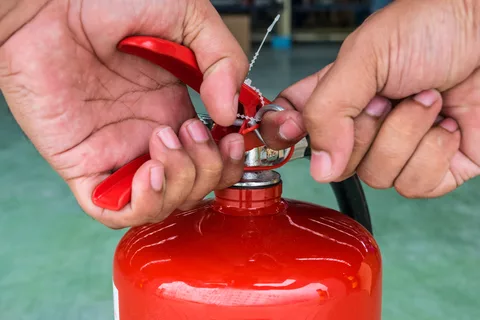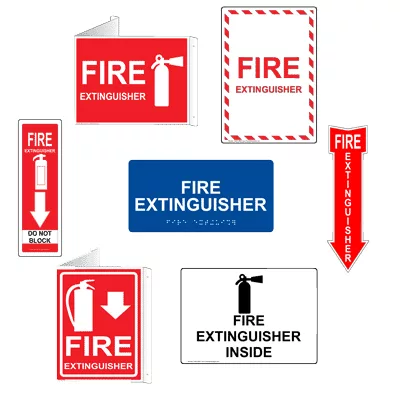
Once your distillery production goes over the Maximum Allowable Quantities the Building and Fire Codes mandate the building must be equipped with fire sprinklers. Once you have fire sprinklers though, are fire extinguishers even needed anymore?
Yes.
Dalkita and every fire professional, ever.
Portable fire extinguishers are the first line of defense in a building. An appropriate extinguisher installed and maintained can keep a fire from becoming large enough to trigger the building sprinkler system. Less stuff burning, less time burning = less damage to your business premises and operations.
What does a properly rated fire extinguisher mean?
Fire extinguishers are classified by the type of burning materials each extinguisher is designed (and tested) to fight.
The number in front of the “A” or “B” relates to the size/quantity of flammable material – broken into size/quantity categories – that the extinguisher can successfully address. Therefore, the larger the number in front of the “A” or “B” – the larger fire it can address.
“A” ratings involve 3 tests: wood crib, wood panel and excelsior (shredded paper) tests.
“B” ratings involve putting out flaming liquid fires as described in square feet (Pan Size) or gallons of heptane.
“C” rating tests involve the non-conductivity of the extinguisher contents based on UL standards. It is a pass/fail test, if it is non-conductive – it gets the “C” rating. No further numbers needed.
For our purposes in a distillery, we will need at least one – most likely more – A B C fire extinguisher. Since our primary risk for fire comes from the fact that we are handling flammable liquids in quantity and potentially in an “H” occupancy – NFPA 10 specifies the basic minimum extinguisher rating for an “Extra (high)” hazard is “40-B” with extinguishers a maximum of 30’ travel distance apart. If you need a bit more space between extinguishers – maximum of 50’ travel distance can be gained with an “80-B” rated device.
Extinguishers are available as a combination ABC, specifically an A, there are even BC only fire extinguishers. The choices can be overwhelming. ABC fire extinguishers are the most versatile and much less expensive than a narrowly focused unit that would be good for only a specific kind of fire – like flammable liquids (a B:C model), for instance.
ABC extinguisher sizes recommended for use in all areas of a distillery:
3A:40B:C
4A:40B:C
4A:60B:C
4A:80B:C
10A:120B:C
Travel distance is different from linear distance. Travel distance means get the extinguisher and back to a potential incident within the specified maximum distance. This means the calculation must factor in going around tables/ equipment/ stacks of barrels to get to the extinguisher and back again. This effectively cuts the max distance in half. Keep this in mind when locating extinguishers and err on the side of safety.
Fire extinguishers also usually have a weight rating. A “10LB ABC” extinguisher weighs 10 pounds. When shopping for an extinguisher take the weight of the extinguisher and the occupants that will be around the installation into consideration. As an example: a 30 LB extinguisher may not be the best option for areas of your facility that interfaces with the public where you can not be sure the people occupying the building (visitors/guests) will be able to heft that amount of weight. However, it may be totally appropriate for the still room where workers routinely heft 50 LB sacks of grain.
A Word about Extinguishers in Kitchens
Not all distilleries serve food or have commercial kitchens. If your facility has a kitchen with the potential for fires involving cooking oils at least one “K” rated device is required within 30’ travel distance of the kitchen equipment.
Installation
Fire extinguishers should be installed along normal paths of travel, including exits from areas of the building. Mount the extinguisher with the included mounting bracket, a suitable hanger/ listed bracket intended for use with a fire extinguisher, or in a cabinet/wall recess – readily visible. In situations where the view of an extinguisher is obstructed additional signage should be installed to indicate the location of the extinguisher.

Extinguishers should have the label with operating instructions facing out. Nothing should cover the manufacturer’s label with operating instructions or the pressure gauge. Tags for recording inspections, maintenance or recharging should be placed on the back of the device, or inside the cabinet, to keep gauges and instructions clearly visible.
Inspections & Recharges
Extinguishers should be manually inspected by in-house staff, and the inspection recorded on the device’s tag, every 30-days to ensure:
The occupant of the space, where a fire extinguisher is located, is the one responsible for getting certified inspections, maintenance and periodic recharging. Certified inspections, and recharges (if needed) are completed or addressed annually.
Need to find a certified fire extinguisher inspector near you?
Search online for “Fire Extinguisher Inspectors Near Me.” There are often local businesses that specialize in this service. They will also be a great resource for purchasing and installing extinguishers/ cabinets/ signage. Additionally, contacting your local fire department may yield a reference or two. Fire Protection Engineers also can provide this service or direct you to someone in your area.
PRO-TIPS:
Assign each extinguisher a unique identifying number and each extinguisher location a unique identifying code to keep track of the equipment.
Print your own asset tags from here: https://www.myassettag.com/BC/Print-Barcode-Labels.aspx
Keep records of properly maintained equipment digitally for easy access.
Keep one spare of each type/style of extinguisher in the case of use or repair so there will always be one on hand.
Take a look at NFPA 10 v.2013 online:
https://www.nfpa.org/Assets/files/AboutTheCodes/10/FI10-2013.pdf
Buy the current NFPA 10 document online:
https://www.nfpa.org/codes-and-standards/all-codes-and-standards/list-of-codes-and-standards/detail?code=10
U.S. Fire Administration – for tips on how to use a fire extinguisher:
https://www.usfa.fema.gov/prevention/outreach/extinguishers.html
Gives a breakdown of the testing and what physical sizes relate to the numerical rating:
http://www.brkelectronics.com/faqs/oem/what-do-the-abc-ratings-mean-on-fire-extinguishers
Fire Extinguisher Retailer – site lists products by size:
https://fireextinguisherdepot.com/fire-extinguishers/fire-extinguishers-by-ul-rating/40b-c.html